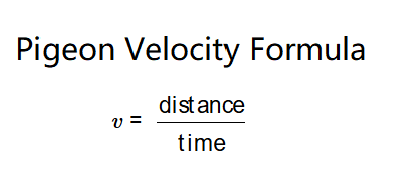 Home
Home
 Back
Back

Definition: A pigeon velocity calculator is a specialized tool designed to determine the speed of a racing pigeon by dividing the distance it travels during flight by the actual time it spends flying, yielding a measure of linear velocity. This calculation provides a precise indicator of a pigeon’s performance, capturing how fast it moves in a straight-line path during races or training flights.
Purpose: Pigeon racers rely on this calculator to evaluate the speed, endurance, and overall performance of their birds, enabling them to identify top performers for competitions or breeding programs. By measuring velocity, racers can assess a pigeon’s health, physical conditioning, and potential value in the competitive world of pigeon racing, where speed is a key determinant of success.
Practical Applications: This tool is invaluable for pigeon breeders and racers aiming to enhance flock quality and race outcomes. For instance, organizations like the American Racing Pigeon Union use velocity data to rank pigeons and declare race winners, while individual owners leverage it to monitor training progress or evaluate performance in races spanning distances from 100 to 600 miles (160–960 km). It also supports historical and recreational pigeon enthusiasts, drawing on the birds’ legacy as swift messengers, from ancient civilizations to wartime communications, and even modern experiments like data transport in low-connectivity areas.
Historical Context: Pigeons have long been celebrated for their speed, famously serving as messengers during World War I and II, where their velocities—often exceeding 60 mph over long distances—enabled critical communications. Today, the calculator connects this heritage to modern pigeon racing, where elite pigeons like Bolt have achieved speeds up to 110 mph in short bursts or maintained 93.75 mph over 420-mile races.
The calculator employs a simple yet effective formula for linear velocity, rooted in basic kinematics:
Where:
Unit Conversions:
Explanation: Users input the flight distance (e.g., 100 miles) and the actual flying time (e.g., 1 hour, 30 minutes, 0 seconds) using the provided fields. The calculator converts the distance to meters and the time to seconds, computes the velocity in meters per second (m/s), and then displays results in m/s, km/h, mph, and YPM, rounded to 3 decimal places. For precision, especially in long races (e.g., 600 miles), use GPS trackers or timers to measure the exact flying time, excluding any stops or rests, as pigeons may pause during extended flights.
Example Calculation: Consider a pigeon flying 100 miles in 1 hour, 30 minutes, and 0 seconds. The calculator converts 100 miles to 160,934.4 meters and 1.5 hours to 5400 seconds, yielding \( v = 160934.4 / 5400 \approx 29.8 \, \text{m/s} \). This translates to approximately 107.3 km/h, 66.7 mph, and 1946.4 YPM, showcasing the pigeon’s impressive speed over a medium-distance race.
Accuracy Considerations: The accuracy of the calculation depends on using the actual flying time, not total elapsed time, as pigeons may rest or detour during long races. Pigeonpedia recommends GPS trackers for long-distance races (e.g., 600 miles) to capture true flying time, ensuring velocity reflects performance rather than downtime.
Significance: Measuring pigeon velocity is a cornerstone of pigeon racing and breeding, offering critical insights for:
Real-World Impact: Pigeon velocity calculations drive competitive strategies in racing, where rigorous training routines—such as flying 20–21 miles in 25–29 minutes—condition birds for peak performance. This data also supports scientific studies on avian biology, highlighting pigeons’ aerodynamic efficiency and endurance, and fuels recreational pigeon keeping, connecting enthusiasts to a rich heritage of speed and reliability.
Guidelines: To maximize the utility of this calculator, follow these steps:
Tips for Accuracy: For optimal results, use longer race distances (e.g., 100 miles or more) and GPS trackers to capture true flying time, particularly in races exceeding 600 miles where pigeons may rest. Avoid calculating velocity during adverse weather conditions—such as fog, strong winds, or heavy rain—as these can significantly affect performance and skew results. This tool is ideal for pigeon racers, breeders, and enthusiasts assessing speed for competitions, training evaluations, or health monitoring, ensuring data-driven decisions in pigeon racing and breeding programs.
Q: What if I enter negative or zero values for distance or time?
A: The calculator sets the velocity to 0 for invalid inputs (negative or zero distance or time), as physical measurements must be positive to calculate meaningful velocity.
Q: Why is actual flying time important?
A: Actual flying time, excluding stops or rests, ensures accuracy, especially in long races (e.g., 600 miles) where pigeons may pause. Using total elapsed time can underestimate velocity, misrepresenting performance.
Q: Can this calculator be used for other birds or objects?
A: While designed for pigeons, it can estimate velocity for other flying objects or birds with similar motion, but results may vary due to differences in aerodynamics, wing structure, or behavior. Adjust inputs accordingly for non-pigeon applications.
Q: What is a typical pigeon velocity in races?
A: Racing pigeons can reach speeds up to 110 mph in short sprints or maintain 93.75 mph over long distances (e.g., 420 miles). Average velocities often range from 40–70 mph, depending on distance, weather, and training.
Q: How does weather affect pigeon velocity?
A: Strong winds, fog, or rain can reduce velocity by increasing drag or forcing detours. Tailwinds can boost speed, while headwinds or turbulence can slow pigeons, making weather a critical factor in race performance.
Q: Why use YPM instead of other units?
A: Yards per minute (YPM) is a traditional unit in pigeon racing, offering a precise measure for short time intervals. It’s widely used by racing organizations like the American Racing Pigeon Union for consistency and historical comparison.